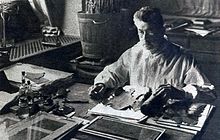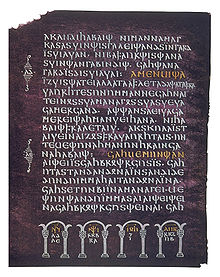Hugo Ibscher
Hugo Ibscher (born September 28, 1874 in Berlin ; † May 26, 1943 there ) was a German restorer who specialized in the conservation and restoration of papyri . He is considered the founder of papyrus restoration.
Life
Hugo Ibscher was born the son of a Silesian foreman who ran a pub in Berlin . He grew up in this milieu until he went to bookbinder Fröhlich's apprenticeship after school . In his dream job, on the one hand, he learned the basics of his later work, on the other hand, he also learned a love for writing materials and the written or printed word, which would later set him apart. He also attended art school and was a member of a gymnastics club . His further professional career took a decisive turn at the age of 16. He became an assistant to the Arabist Ludwig Abel , who sought help with his work from Fröhlich. From Abel, Ibscher first learned how already cleaned and smoothed papyri were framed between two panes of glass. He quickly learned the other work processes and surpassed Abel in his skill. During his apprenticeship, he got to know the typefaces of ten different languages, including Latin , ancient Greek , Arabic and Aramaic . In addition, Ibscher showed a great understanding of the structures of the papyri, such as the course of the fibers, the smallest color nuances and the assembly of the smallest parts. Ibscher was considered a genius in his field. When Abel was appointed to the University of Erlangen in 1896 , Ibscher remained solely responsible in Berlin. He quickly developed into one of the most renowned experts in the field of papyrus studies.
At the turn of the 19th and 20th centuries, the Berlin papyrus collection, under the direction of Wilhelm Schubart, grew from a small collection to one of the largest collections of its kind worldwide, for example through the targeted acquisitions of the German Papyrus Cartel . With researchers such as Schubart, Ulrich Wilcken , Adolf Erman and Ulrich von Wilamowitz-Moellendorff, Berlin developed into the international center of papyrology , which at the time was the youngest subject in classical studies . Because of his skills, he was quickly entrusted with valuable pieces such as the Elephantine papyri . Ibscher was not even 30 years old when he discovered the “Persians” of Timotheus, one of the most important examples of literary papyri. Now other research centers became aware of Ibscher. In 1907 he went to England for the first time, where he was to travel particularly frequently in the future. Shortly before the outbreak of World War I and one of Ibscher's last trips to England, Minister of Culture Carl Heinrich Becker described him as “a good, silent message from Germany to foreign countries that no good ambassador could better fulfill.” There were more calls from abroad: In the At Uppsala University Library , he restored the Codex Argenteus , the Gothic Bible of Bishop Wulfila . He restored the Vicke-Schorler roll for the Rostock city archive . Thereupon the University of Hamburg awarded him an honorary doctorate in 1926 . In the Vatican he restored papal documents and was even on friendly terms with Pope Pius XI. Further stays abroad followed, some several times in Istanbul , Copenhagen ( Avesta addresses ), Turin , Vienna , Paris and, to Ibscher's particular delight, in Cairo . The Prussian Academy of Sciences honored him with the Silver Leibniz Medal in 1926 , as did the Bavarian Academy of Sciences . He was awarded the Dannebrogden by the Danish king, and in 1927 he was awarded the command of the Papal Order of Gregory .
Since the 1930s Ibscher threw himself more and more into his work. Only the trips abroad, which often involved restoration work other than that of papyri, became phases of relaxation. The most difficult thing for him was probably the restoration of the Manichaean manuscripts , which had already rotted, matted together and had been under water for centuries. Ibscher was able to work out seven papyrus books from the mountain of leaves that was considered unsaved. Half of the find belonged to Berlin and half to the patron Alfred Chester Beatty . Not least because of Beatty's trust in Ibscher, the entire complex remained in Berlin, even when the Second World War seemed almost unavoidable in 1939 . Beatty also had other texts restored by Ibscher, for example one of the earliest finds of biblical texts. The outbreak of war had a lasting impact on Ibscher's work. He no longer had the calm he needed for his difficult work. By chance he came to an order of the Berlin State Library , on whose behalf he opened up a new workspace: He saved manuscripts of Johann Sebastian Bach in front of ink corrosion . Here he used the same technique that he had already successfully used for the Avesta manuscripts in Copenhagen: the documents were covered with chiffon silk from Lyon .
For the time after the war Ibscher wanted to devote himself exclusively to the difficult cases abroad, with which the "Papyrus Doctor" wanted to help in order to save them. There were now other restorers in Germany, including his son Rolf Ibscher , who, like his father, worked on the Berlin collection. Due to an invitation from Gerhart Hauptmann - a photograph of Ibscher's hands during the restoration of a papyrus inspired him to consider the "thinking hands" - he was preparing a trip to Vienna and Agnetendorf , where he wrote Hauptmann's first writings on the Jesus He was to secure studies for his later Emanuel Quint novel when he suddenly suffered a stroke and died.
Ibscher remained connected to his origins throughout his life. He was chairman of the Federation of German Bookbinding Guilds . In 1927 he founded the monthly magazine Der Buchbinderlehrling .
literature
- Festschrift for the 50th birthday of the executive chairman of the Federation of German Bookbinding Guilds Hugo Ibscher, Berlin-Charlottenburg, on September 28th, 1924. Dedicated to its founder by the Buchbinderei-Beisitzer-Vereinigung der western suburbs of Berlin e. V., seat in Charlottenburg , Association of Bookbinderies Assessor of the Western Suburbs of Berlin, Berlin-Charlottenburg 1924.
- Bruno Snell : Greek papyri from the Hamburg State and University Library with some items from the Hugo Ibscher collection. Augustin, Hamburg 1954.
- Rolf Ibscher: Hugo Ibscher in memory. In: Das Altertum , Volume 5, 1959, pp. 183-189.
- Hans Georg Gundel : Giessen papyrologist in correspondence with Hugo Ibscher. New materials on the history of the Giessen papyrus collections between 1927 and 1945 . Brief reports from the Giessen papyrus collections 17. Giessen 1964. PDF
- Myriam Krutzsch: "Patience wants to be at work". In memory of Hugo Ibscher's start of self-employment in the Berlin Papyrus Collection in 1894. In: Archive for Papyrus Research and Related Areas , Volume 40, 1994, pp. 165–166.
Web links
- Literature by and about Hugo Ibscher in the catalog of the German National Library
- Remarks of Todd Hickey, Assistant Research Papyrologist and Curator of papyri for the Center for the Tebtunis papyri and The Bancroft Library, at the presentation of the Hearst papyri delivered to Berkeley after 104 years (English)
Individual evidence
- ↑ Wolfgang Müller , Rolf Ibscher, Otto Werner Luke: On the chiffoning of the papyrus roll P. 11651 , In: Research and reports Volume 6, 1964, pp. 97-101.
- ↑ Quoted from Rolf Ibscher: Hugo Ibscher zum Gedächtnis , In: Das Altertum 5, 1959, p. 186.
- ↑ AAS 20 (1928), No. 3, p. 94.
| personal data | |
|---|---|
| SURNAME | Ibscher, Hugo |
| BRIEF DESCRIPTION | German restorer |
| DATE OF BIRTH | September 28, 1874 |
| PLACE OF BIRTH | Berlin |
| DATE OF DEATH | May 26, 1943 |
| Place of death | Berlin |

